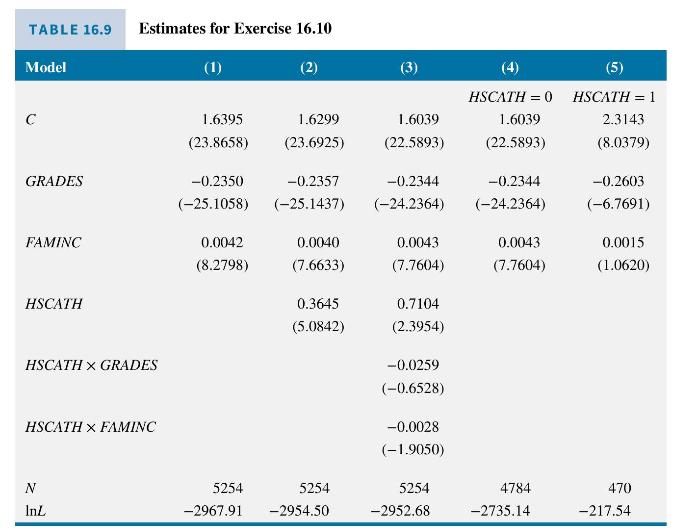Consider a probit model explaining the choice to attend a 4-year college rather than a 2 -year
Question:
Consider a probit model explaining the choice to attend a 4-year college rather than a 2 -year college by high-school graduates who chose to attend a postsecondary school. Define \(F O U R Y R=1\) if a high-school graduate chooses 4-year college and FOURYR \(=0\) if the high school graduate chooses a 2-year college. We use explanatory variables GRADES, 13 point scale with 1 indicating highest grade (A+) and 13 the lowest \((\mathrm{F}) ;\) FAMINC, gross family income in \(\$ 1000\) units; and HSCATH \(=1\) if the student attended a Catholic high school and \(H S C A T H=0\) otherwise. Table 16.9 contains some probit model estimates.

a. Using Model (2), how large an effect on the probability of attending a 4-year college does attending a catholic high school have for a student with \(G R A D E S=5\) (B) and family income of \(\$ 100,000\).
b. Comparing Models (2) and (3), are the interaction variables HSCATH \(\times\) GRADES and \(H S C A T H \times\) FAMINC jointly significant at \(5 \%\) using a likelihood ratio test?
c. Can we interpret the Model (3) results as saying an increase in family income reduces the probability of attending a 4-year college for someone graduating from a Catholic high school? What is the marginal effect of an additional \(\$ 1000\) in family income for a Catholic high school student with GRADES \(=5\) (B) and family income of \(\$ 50,000\) ?
d. Using Model (3), compute the probability of attending a 4-year college for someone graduating from a Catholic high school with GRADES \(=5\) (B) and family income of \(\$ 100,000\). Compare this probability to a student who did not attend a Catholic high school but has GRADES \(=5\) (B) and family income of \(\$ 100,000\).
e. Using Models (1) and (3), test the null hypothesis that the probit model parameters are the same for students who attend and do not attend a Catholic high school. Use a likelihood ratio test at the \(5 \%\) level of significance.
f. Using Models (4) and (5), estimate the probit model separately for \(H S C A T H=0\) and \(H S C A T H=1\). Compute the sum of the log-likelihood functions values. Compare the sum to the log-likelihood for Model (3). Algebraically show that this is not an accident.
Step by Step Answer:

Principles Of Econometrics
ISBN: 9781118452271
5th Edition
Authors: R Carter Hill, William E Griffiths, Guay C Lim





